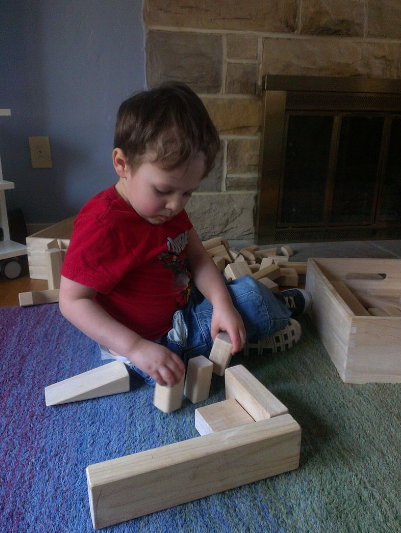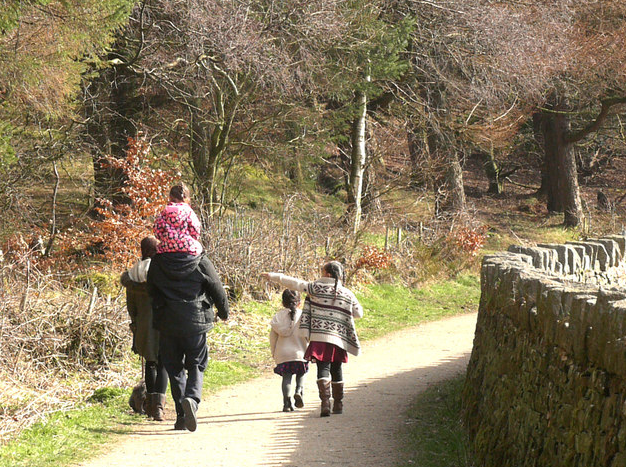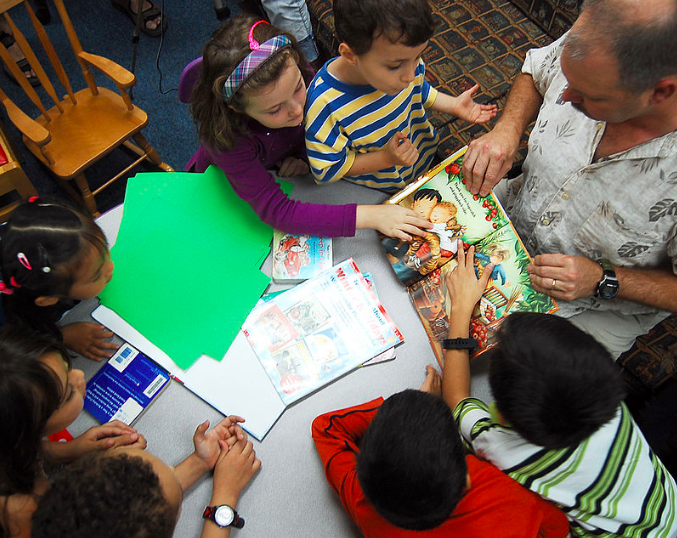Play is an essential way for kids to interact with and learn about the world around them. According to the Kenneth R. Ginsburg of the American Academy of Pediatrics, “play is essential to the cognitive, physical, social, and emotional well-being of children and youth.” Parents perform an important role in this learning process: through one-on-one or group play, parents model language and encourage linguistic development in their children, as well as teach social and cultural norms. What “play” looks like will vary across age groups, but parental involvement is always important.
As minority languages, access to signed languages is limited in larger society. Promote the use of sign language in your home by creating a safe environment for your children to play with the language and develop their skills. Here are 10 different activities to help encourage language development within your home!
1) Language Play
Grab a few toys around the house and utilize them as tools to create opportunities for sign language play! Depending on the age of your child different toys may be used, but the strategies can stay the same. Use building blocks, play dough, or other materials to create something and then take turns using classifiers to describe it. For older children language play ideas such as KODAheart’s Family Activities like ASL A to Z , Mitten activity or even follow the crowd in the newest fad- Pokemon GO.
According to Joan P. Isenberg and Mary R. Jalongo, language play is critical to language development. Providing space for your child to experiment or play with language allows them to strengthen their skills.
2) Play with Classifiers
Play with descriptive classifiers as a family with a game of “I Spy with My Little Eye.” Take turns describing an object in your surrounding environment, while others attempt to guess which object you are describing. Discuss how mouth-gestures work in conjunction with handshape and movement to indicate differences in shape, texture, depth, and size. Classifiers can be fun to create and allow the signer to play with language.
Classifier construction is a feature of ASL that is not shared with English, so this is a great activity if you are trying to encourage your child to “think” in ASL. Descriptive classifiers are handshapes that are used in signed languages to describe objects, environments, or people. For example, classifiers may be used to depict the pattern on one’s shirt or describe how a person’s mustache is shaped.
3) Rhythm and Rhyme
Encourage your family to use signed language by making up your own family song or rhyming story! Work together to develop a list of rhyming signs, then showcase these ideas with a catchy rhythm. Your song is perfect for cheering for a family member during a sporting event or riding in the car on a road trip. What kinds of songs or stories will your family create?
Rhyme and rhythm are helpful in encouraging language acquisition because they make learning engaging and encourage children to practice in a fun way. English rhyming occurs with words that look and sound the same (like same and fame). In American Sign Language, rhyme and rhythm appear through signs that have similar handshapes or motions. Gallaudet University’s “Bison Song” is a great example of how signed languages use rhythm. For more information on the importance of rhyme and rhythm in language acquisition, Handsland has a few video examples to get you started!
4) Grammatical Non-Manual Markers
Explore how can facial expressions change the meaning of the words we use with a word game. Choose one sign or phrase and take turns repeating it with a different expressions. As a family try to answer the following questions; Can you make your word into a question by changing your expression? How does it change if you add a head-shake? Can you come up with facial expressions don’t change the meaning of the sign?
In sign language most facial expressions are meaningful. For instance, a small change to your eyebrows can change a statement into question. Linguists have divided facial expressions into two groups; communicative non-manuals and grammatical non-manuals. Communicative non-manuals are facial expressions like smiles – they convey emotion or attitude, but do not change the meaning of the sign or sentence. Grammatical non-manual markers, on the other hand, change the meaning of a word or phrase. Like the eyebrow example described above, they convey information about sentence type. According to Dr. Chen Pichler, contemporary research suggests that babies that are exposed to sign language may begin to use some grammatical non-manual markers at around three years old!
5) Real-world Applications
Grab a family photo album and talk about various family members with your child. Ask and answer questions with them; where are they, what are they doing, what do they look like? Incorporate language and explore your environment. Take a walk around the neighborhood or local park, point out the different activities of people in the park, or describe environmental settings you come across.
Many of us are familiar with the adage “practice makes perfect.” According to Early Childhood News, this is the case with language as well! Make the process of learning language engaging and relevant by incorporating real life examples. Almost any daily activity can be used as a tool to build your child’s sign language skill and vocabulary. The more exposure your child receives to signed languages (and the more models with which they have contact) the stronger their skills they will become. Think about expanding the opportunities they have to see and use signed languages everyday!
6) Depicting Verbs
Use depicting verbs to tell make up a story as a family! To play, sit in a circle and begin a story about a car on a trip. Have each member take turns adding depicting verbs to the story and depict the car’s journey. In another round, take turns coming up with a sign that can be turned into a depicting verb. How many can you come up with? How silly can you get?
Depicting verbs are another unique feature of signed languages. These verbs describe both the action or activities of people or objects, as well as some aspect about them. For instance, depicting verbs can be used to describe a car driving on a road. By modifying movement and location, the road can be bumpy or smooth, the car can be driving up or downhill, or weaving side-to side. Depicting verbs can also be created by manipulating a regular sign. For example, in American Sign Language the sign BIRD can be made depictive by adding movement to the bird’s beak.
7) Cinematic Signed Language
Play with the cinematic features of signed language as a family. As family pick a story and have each member take a scene and re-tell it in sign language. Try to focus on the timing, location, and to emphasize features of the story. Here is a great example video.
Storytelling and other performances often incorporate a linguistic feature that is unique to signed languages; a visual cinematic vocabulary. This vocabulary has been described as “visual vernacular” by Bernard Bragg. It includes the ability to depict a story from multiple angles, and to modify space and time in a way that references the use of zoom or slow-motion in cinematic films. For example you can speed up or slow down a sign to modify tone or play with emphasis. You may also tilt your head or change your eye gaze to incorporate different angles.
8) Language Variation
Expose your family to diverse sign languages and vocabularies by getting out into the community! From your local deaf club to a national or regional conference, these events offer opportunities for your family to interact with many different signers. Encourage them to ask new signers about the signs they use; sports team names and US states are a great place to find examples of language diversity! At home, you can play videos by different sign language performers. Start with KODAheart’s collection of storytellers on youtube if you need some inspiration!
Just like spoken languages, signed language can vary based on a person’s geography, age, or race. For instance, regional differences in American Sign Language have led to variation in the sign for BIRTHDAY. These differences have developed over time as a result of many factors, including the policies of deaf residential schools, geographic region, generational and cultural differences.
9) Vocabulary Development
Choose a word/phrase and take turns coming up with all the possible ways that it can be signed. Imagine different contexts in which the sign may be generated differently. What silly ways can you come up with? Expand this activity by hosting a sign language version of Scattergories at your home. Invite signing friends and go head-to-head. The team that creates the longest list or most number of unique signs wins!
Signed and spoken languages vary in the construction of verbs and nouns. The rules that apply to a visual language typically do not apply to spoken languages and vice versa. For example the English word “run” can be interpreted in sign language with various signs, all depending on context of how the word is used in the sentence.
10) YOU are the best resource for your child’s acquisition of signed language.
Encourage your child(ren) to increase their vocabulary by asking questions that require them to expand and add information to their statements. For instance, if your child is talking to you about a car that drove by, use that opportunity to model vocabulary and grammar. Repeat their statements, being sure to correct sign formation or sentence structure. Demonstrate the use of classifiers by introducing the 3-handshape classifier in your reply. Ask questions about the color and shape of the car, as well as its movement and direction. These exchanges will help to model appropriate sign language structure, while also encouraging language use in your family!
Often people assume that language needs to be taught in a formal setting, but this is not true. In everyday situations, you model language with your children. Parents, even if they are not native signers, have a great impact on their child’s language development. Research suggests that children will regularize and correct the input they receive.
Language play encourages children and parents to expand vocabulary, explore the grammar and structure of language, and learn about different forms of communication. In small ways, everyday, families shape the process of language acquisition at home. While there is no one way to learn language, parents can create language-rich environments that encourage children to explore and develop their skills, while also bringing the family together!
What language development strategies do you utilize at home? Which games are a family favorite? Share them with us at oneKODAheart@gmail.com
Special thanks to Dr. Jeffrey Palmer for his input and feedback on this article.
Photo Credits:
[1] Playing with blocks
[2] Smiling baby
[3] Family walk
[4] Family read
![[Image Description: A thumb, outlined in black, signs “10” with accompanying text that reads: “KODAheart’s [10] Linguistic Development tips for a signing family.” In the background to the right, a set of hands sign the word “Grow”.]](http://kodaheart.com/wp-content/uploads/2016/11/lingdev10-1024x1024.jpg)

![[Image Description: A black and white photograph of a smiling infant leaning on table.]](http://kodaheart.com/wp-content/uploads/2016/11/Screen-Shot-2016-11-12-at-3.16.27-PM.png)

